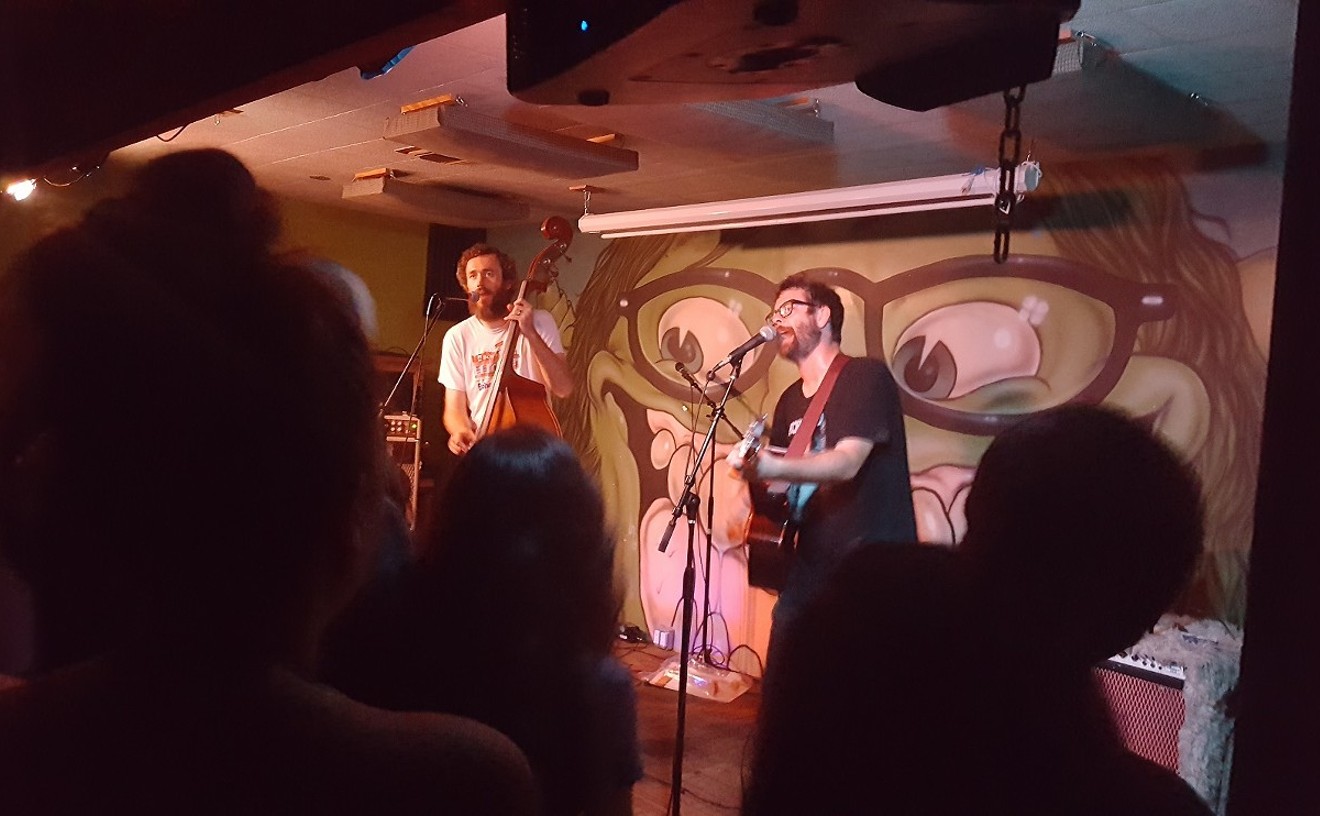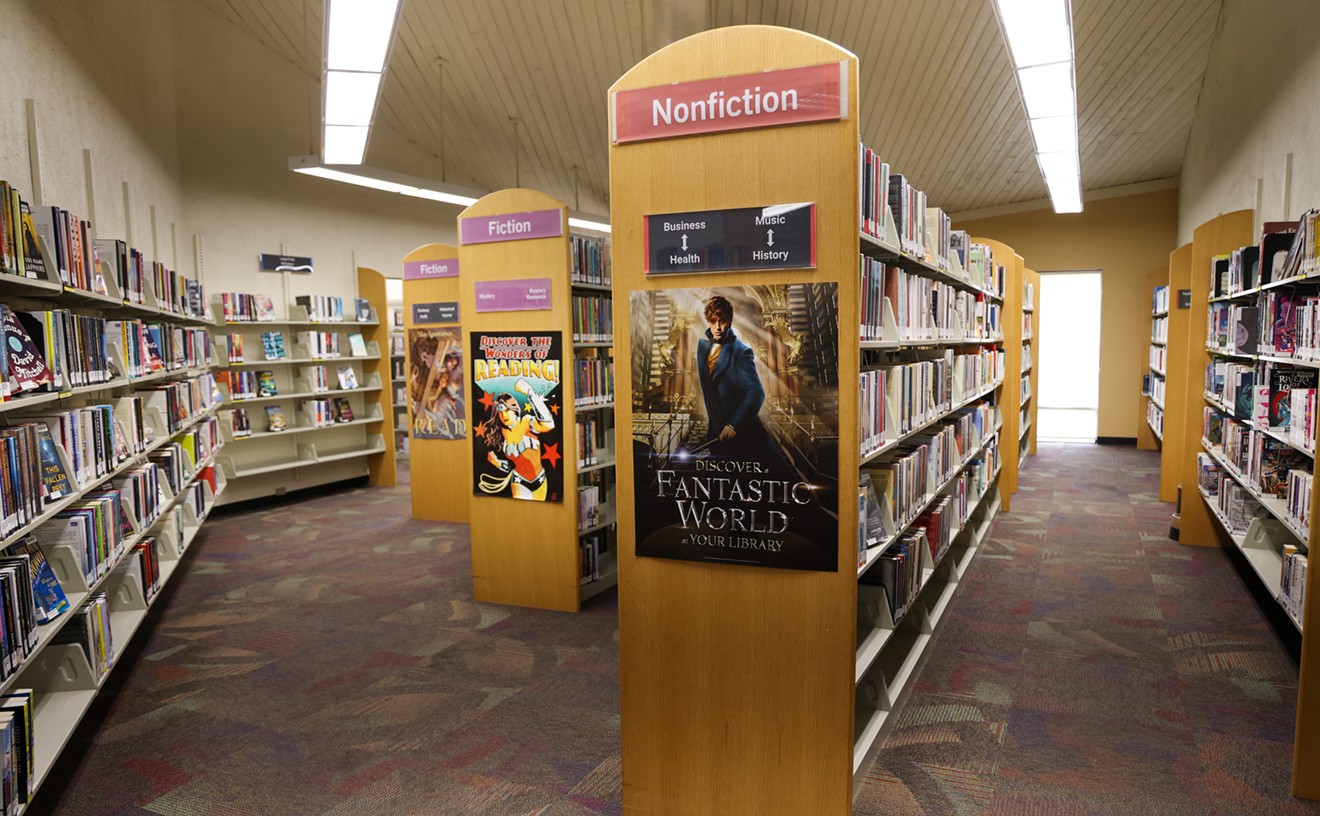In her solo show at the Burton Barr Central Library and group show at Mesa Contemporary Arts, she uses old historical texts and documents to wage an arty war against history's multitude of oppressive forces. Her weapon isn't the heady philosophical discourse found in most political art. It's merely a sewing machine.
Following a practice she developed as a graduate student at ASU in 1996 and 1997, she plays the creative seamstress, dismantling pages from books and historical documents and stitching them end to end to form a large paper fabric. In works like Market Driven in Mesa or Sublimation at the library, she further breaks up the flow and the meaning of the words by sewing a tight grid across the surface; then she stains, dyes and otherwise distresses the fabric. The resulting sheets of words have the faded and lost appearance of an urgent letter from your child's teacher that's been mistakenly tumbled in the family wash. Yet the political and historical points of Lewis' collages are easy to see.
Market Driven may look like a sweeping wall hanging of fresh linen. But its textual fragments are from the 1866 treaty between the Italian and Chinese governments.
In Reclamation, Lewis uses text from a Hebrew prayer to address the Holocaust. The work is divided into five main pieces of sewn pages, each dyed with two rust-colored designs. These designs begin at the edge of the fabric as an Iron Cross, a symbol of Germany's Third Reich, and a Star of David, a symbol of Judaism. As the panels converge, these signs disintegrate into more abstract, indefinable characters.
Most politically inspired work is as subtle as a karate kick to the groin. But Lewis' art is a nice departure. It poses the poignance of the history behind the words with the beauty and physical frailty of the new forms she's given them. As a work of art, Reclamation is more powerful than Market Driven. Yet both raise questions about the wisdom of using the history of oppressed cultures as fodder for artwork.
Lewis' reliance on politically charged texts runs the risk of transforming her art into a visual syllabus for a university course on the history of oppression. For example, Market Driven deals with 19th-century China, Reclamation with the Holocaust, and yet another pertains to Communist Russia. Such jumps from one period of oppression to another make one wonder where Lewis' true sentiments lie, and whether she's using history merely to add depth to an attractive art process.
The library exhibit shows the evolution of Lewis' work since her 1997 ASU thesis show. The works are a mixed bag. Conversation, Sublimation and other earlier works are large-scale wall coverings that have a beauty and power you don't find in her more recent examples. Newer sculptural works, like Old Bag, seem to be lacking artistically and conceptually.
In Old Bag, Lewis takes a 1950s-style vacuum cleaner and distresses the surface to make it appear as though it's covered with rust. The vacuum bag gets its own special treatment -- passages from Jane Fonda's workout books. This clever and intriguing combination merges old-fashioned suburban domesticity with the evolving lure of physical fitness and the idea of Fonda as a powerful, independent woman. But the work is more in tune with recycled thrift-store art than anything else.
History Teaches Nothing is another installation/sculptural piece, but it, too, comes across as a bit tedious and lacks the subtlety of Lewis' earlier work. It consists of a wooden desk holding an antique typewriter. Out the back and onto the floor, the old machine spews a sewn Russian history text on World War II. To add to the effect of the piece, Lewis repeatedly burned hammers and sickles from the Communist flag into the text. And she replaced the letters on the typewriter with smaller fonts.
The failure of this work is in its punch-in-the-gut sentiments and painfully obvious political message. It becomes what it appears to condemn by replacing the subtlety of Lewis' earlier work with preachiness.
Loved to Death is another piece that should have been left in the studio. The work is a wall hanging made of newspaper that's been cut into an intricate design and laminated with a transparent fabric. There's beauty in the shadow that the work casts against the wall. But the appeal ends there. The newspaper clippings pertain to the death of Princess Diana. And to drive her point home, Lewis places a large Valentine-style heart, made out of various color images of Lady Di, smack in the middle of the piece. The result is akin to the crafty mementos left by thousands at the princess's grave and crash site.
Given Lewis' earlier work, it is hard to understand why someone who has such an obvious disdain for oppressive, tyrannical systems would make such a cheesy monument to a member of a monarchy. It's like Ralph Nader doing public relations for General Motors. If this was satire à la Jeff Koons, it would be understandable. But, in the context of Lewis' other works, it is simply baffling.
Lewis is a talented artist who has developed a compelling and beautiful artistic process. However, she's clearly having difficulty advancing her ideas beyond the quiet simplicity of the earlier pieces. Perhaps all that text has given her a case of writer's block.










